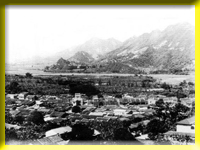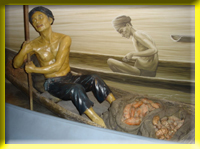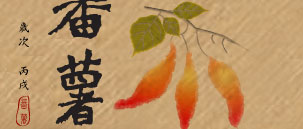





|
|
|
| |
Sweet Potato Street, Fengshan
|
|
| |
|
|
|
| |

Sweet Potato Street, Fengshan, Kaohsiung.
|
|
|
| |
| |
During 1940s while World War II was on, the rice harvested in Taiwan had to be shipped to battlefields that the rice stored in Taiwan was insufficient. After the war, rice became expensive and getting rice for daily eating became difficult in the ruined island that farmers planted sweet potatoes, which were cheaper then, as general foods. The “Sweet Potato Street” in Fengshan therefore became the market for wholesale.
Those who are over 40 years old could have clear memories of eating sweet potato chips. In the past, rice with sweet potato chips was the staple food. But these days as people get richer and richer, eating sweet potato chips becomes a pleasure of modern life. In Lane 312, Kuang-Yuan Rd., Fengshan, there are still several old stores trading sweet-potato-made commodities. They have been here for more than 50 years and a precious memory of old Fengshan habitants.
|
|
|
| |
| |
|
| |
| |
|
| |
Cishan, located in the northern east of Kaohsiung County, were called “the Sweet Potato Hut” in the past. Tarurian of Pingpu tribes who immigrated from Neimen were the first inhabitants here in the Ming dynasty. About 1700, settlers from Zhangzhou, China, started calling this place “the Sweet Potato Hut”. In 1888, it was named “Taiping Village” on the rental list published by Taiwan’s government. During the period that Taiwan was governed by Japan, there were about 300 households or 1000 habitants in this town. After “Bureau of Sweet Potato Hut” was settled in 1901, the layout of the town was significantly modified to form the prototype of modern Qishan. Old narrow streets became straight and wide ones. |

The only stone-made arch corridor in Taiwan.
|
|
|
| |
| |

Sweet Potato Hut in the Japan-governed age.
|
According to the historical records, there was no such town before Qing Dynasty. People say that a mercy old woman made a crude hut near the crowded ferry, selling homemade sweet potato soup to satisfy travelers and merchants. She was admired by passengers and became famous. Time goes on, that site were called “the Sweet Potato Hut”. On the east side of this town lies a hill whose shape is like an ancient battle flag flying in the sky. For this reason, after Japan took off Taiwan, local officers decided to name that hill “Flag Tip Mount” and this town “Flag Mount.”. After the World War II, this town was renamed “Qishan”, it’s current name. |
|
|
| |
| |
|
| |
| |
| |
“Sweet Potato Market Street” in Moungar(Wanhua)
|
|
| |
|
|
|
| |
| |
Kuiyang Street, the oldest street in Taipei and the earliest street in Moungar, was called “Sweet Potato Market Street”. It’s true to say that the prosperous Taipei City originated from Wanhua. In 1723, immigrants from Jingjiang City, Nan’an City & Hui’an County, Quangzhou, China came overseas and built several huts here. They made a living by selling sweet potatoes and gradually formed a little village, called “Sweet Potato Market”. When Han Chinese landed at the river mouth beyond the embankment and went to Moungar to cultivate, they often trade lots of sweet potatoes with canoe-sailing Ketagalan Pingpu tribes, so they called this place “the sweet potato market”. This is the beginning of commercial actions in Taipei City and achieves the current prosperous Taipei. |

Canoe-sailing Kategalan Pingpu tribes are trading sweet potatoes.
|
|
|
| |
| |

“Huan-tsu market street”
|
“Sweet Potato Market Street”(Kuiyang Street)is the start point from where ancestors developed Moungar. It is the one having the longest history in Taipei too. There are several so called “centurial stores” such as Xin-Xie-Ho herbal store, Moungar Church and Chinghshan temple lining along this street. During the period when Taiwan was under the government of Japan, “Sweet Potato Market Street” was renamed to a similar-pronounced name, “Huan-Ci market street” and classified a red-light distinct that many Japanese brothels opened and inhabitants were mainly Japanese. Now the bloom of the street is gone and only a few traditional industries remain. |
|
|
| |
| |
| |
|
| |
| |
|
|




